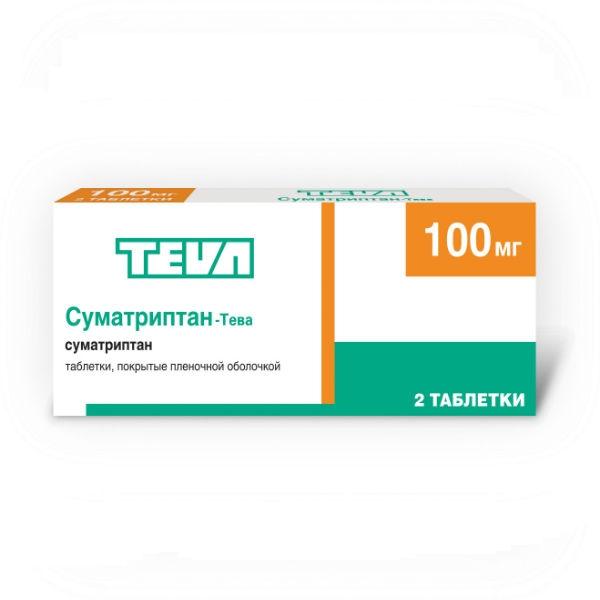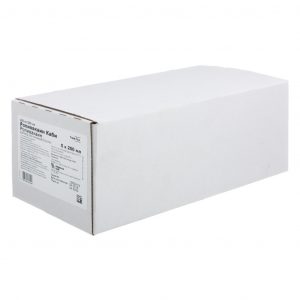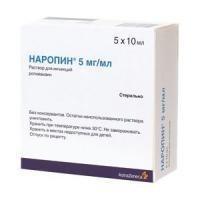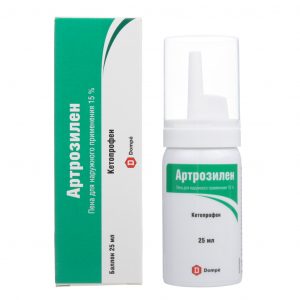Description
Release form
Film-coated tablets.
Packing
2 pcs – blisters made of polyvinylidene chloride and aluminum foil (1) – packs of cardboard.
Pharmacological action of
Sumatriptan is a specific selective agonist of 5HT1D-serotonin receptors (5-hydroxytryptamine-1-like) located predominantly in the blood vessels of the brain. Stimulation of 5HT1D-serotonin receptors leads to vasoconstriction. The drug does not affect other subtypes of 5HT-serotonin receptors (5HT2-5HT7).
In experimental studies, it has been shown that sumatriptan causes selective narrowing of the carotid arteries, which supply blood to extracranial and intracranial tissues, including meninges (the expansion of these vessels and / or their edema is the main mechanism for the development of migraine in humans), without having a significant effect on cerebral blood flow.
It has also been experimentally found that sumatriptan inhibits the activity of the terminal receptors of afferent trigeminal fibers.
Eliminates nausea and photophobia associated with a migraine attack.
Pharmacokinetics
Absorption
After oral administration, sumatriptan is rapidly absorbed, after 45 minutes its concentration in the blood plasma reaches 70% of the maximum value. After oral administration of sumatriptan in a dose of 100 mg Cmax in blood plasma is achieved after 2-2 / 5 hours and averages 54 ng / ml. Absolute oral bioavailability averages 14% due to presystemic metabolism and incomplete absorption.
Distribution of
Plasma protein binding is 14-21%, total Vd averages 170 L (2.4 L / kg).
Metabolism
Sumatriptan is metabolized by oxidation with the participation of MAO (mainly isoenzyme A) with the formation of metabolites, the main of which is the indole acetic analog of sumatriptan, which does not have pharmacological activity against 5HT1 and 5HT2-serotonin receptors, and its glucuronide.
Excretion of
T1 / 2 is 2-2.5 hours. On average, plasma clearance is 1160 ml / min, renal clearance is 260 ml / min. Extrarenal clearance is 40% after oral administration. It is excreted by the kidneys, mainly in the form of metabolites (97% after ingestion) of free acid or glucuronide, the rest is excreted by the intestines.
Indications
migraine (for relieving seizures, with or without an aura).
Contraindications
hemiplegic, basilar and ophthalmoplegic forms of migraine
ischemic heart disease (including myocardial infarction, post-infarction cardiosclerosis, Prinzmetal angina)
patients with heart disease or cardiomyopathy a history of)
occlusive peripheral vascular disease
uncontrolled arterial hypertension
severe hepatic and / or renal failure
simultaneous use with ergot alkaloids and their derivatives (including methysergide) or other tryptamines receptors MAO and the period up to 14 days after their cancellation
age up to 18 years, patients over 65 years old
lactose intolerance, lactase deficiency, glucose-galactose malabsorption
increased sensibility itelnost to sumatriptan or other components of the formulation.
With caution
Epilepsy (including any condition accompanied by a decrease in the seizure threshold of anamnesis), organic brain damage, controlled arterial hypertension, impaired renal function and / or impaired liver function of mild to moderate severity, pregnancy.
Use during pregnancy and lactation
Despite the fact that the safety data obtained with the use of sumatriptan in 1000 women in the first trimester of pregnancy do not contain sufficient information, there are no grounds to draw definitive conclusions about the risk of developing congenital malformations in the fetus. Experience with sumatriptan in the second and third trimester of pregnancy is limited. The use of sumatriptan during pregnancy is possible only if if the intended benefit to the mother outweighs the potential risk to the fetus.
Breast-feeding should be discontinued during the use of sumatriptan and within 24 hours after the end of its use.
Composition of
In one tablet 100 mg contains:
active substance: sumatriptan (sumatriptan succinate) 100.00 mg (140.00 mg)
excipients: lactose monohydrate 140.00 mg, croscarmellose sodium 3.00 mg, microcrystalline cellulose 13.50 mg, colloidal silicon dioxide 0.50 mg, magnesium stearate 3.00 mg
shell Opadry II 33G28707 white (hypromellose (E 464) 4.0000 mg, titanium dioxide (E 171) 2.4000 mg, lactose monohydrate 2 , 2000 mg, macrogol-3000 0.8000 mg, triacetin 0.6000 mg).
Dosage and administration
Inside (the tablet is swallowed whole with water).
Initial single dose of 50 mg, if necessary, the dose can be increased to 100 mg. If the symptoms of migraine do not disappear and do not decrease after taking the first dose, then taking a second dose to stop an ongoing attack is not prescribed. To stop subsequent attacks (with the reduction or disappearance of symptoms, and then resuming), you can take a second dose over the next 24 hours, provided that the interval between doses is at least 2 hours.
The maximum daily dose for oral administration is 300 mg.
Side effects
The incidence of side effects is classified according to the recommendations of the World Health Organization: very often – at least 10% often – at least 1%, but less than 10% infrequently – at least 0.1%, but less than 1% rarely – at least 0.01 %, but less than 0.1% is very rare – less than 0.01% (including isolated cases).
From the cardiovascular system: very rarely – bradycardia, tachycardia, arrhythmia, transient increase in blood pressure (BP) (immediately after treatment), transient signs of myocardial ischemia on the ECG, coronary spasm, myocardial infarction, Raynaud’s syndrome, decreased blood pressure , “Flushing” of blood to the face.
From the respiratory system: often – shortness of breath, transient irritation of the mucous membrane or burning sensation in the nasal cavity or throat.
From the digestive system: often – nausea, vomiting, a slight increase in the activity of “liver” enzymes is very rare – ischemic colitis, diarrhea, a feeling of discomfort in the abdomen.
From the nervous system: often – dizziness, drowsiness, impaired sensitivity, including paresthesia, hypesthesia very rarely – cramps (usually with a history of seizures) unknown frequency – tremor, dystonia, anxiety.
From the side of the organ of vision: infrequently – diplopia, flickering of flies before the eyes, nystagmus, scotoma, decrease in visual acuity is very rare – partial transient loss of vision (it should be borne in mind that visual impairment can be associated with the attack of migraine itself).
From the side of the musculoskeletal system: often – myalgia, unknown frequency – stiff neck, arthralgia.
Allergic reactions: very rarely – skin rash, urticaria, pruritus, erythema, anaphylaxis.
Other: often – pain, tingling, feeling hot, feeling weak and / or tired, nosebleeds, feeling of constriction or heaviness (these symptoms are usually transient, but can be intense and occur in any part of the body, including the chest and neck) unknown frequency – excessive sweating.
Drug Interaction
Sumatriptan does not interact with propranolol, flunarizine, pizotifen and ethyl alcohol.
Concomitant administration of sumatriptan with ergot alkaloids and their derivatives (including methysergide) or other 5HT1-serotonin receptor triptans / agonists is associated with an increased risk of long-term vascular spasm and ischemia. Sumatriptan can be used no earlier than 24 h after administration of ergot alkaloids and their derivatives or other 5HT1-serotonin receptor tryptans / agonists, in turn, preparations containing ergot alkaloids, can be taken no earlier than 6 h after taking sumatriptan, other triptans / 5HT1-serotonin receptor agonists can be taken no earlier than 24 h after taking sumatriptan.
Interaction between sumatriptan and MAO inhibitors is possible, and their simultaneous use is contraindicated.
There are very rare reports of post-marketing surveillance on the development of serotonin syndrome (including mental disorders, autonomic lability, and neuromuscular disorders) with concomitant use of sumatriptan with selective serotonin inhibitors. The development of serotonin syndrome has also been reported with the concomitant use of tryptans with selective serotonin and noradrenaline reuptake inhibitors (SSRIs).
Isolated reports of a more pronounced manifestation of adverse reactions by sumatriptan when used with herbal preparations containing poultry.
Overdose
With single subcutaneous administration at a dose of 12 mg, sumatriptan did not cause any side effects. With subcutaneous administration at a dose of more than 16 mg or when taken orally more than 400 mg, sumatriptan did not cause any unintended side effects other than those listed above.
Treatment: gastric lavage, activated charcoal intake, patient monitoring for at least 10 hours, symptomatic therapy if necessary. There are no data on the effect of hemodialysis and peritoneal dialysis on plasma sumatriptan concentration.
Storage conditions
Store at a temperature not exceeding 25 ° C. Keep out of the reach of children.
The Expiration of
is 3 years.
Deystvuyuschee substances
sumatriptan
pharmacy leave terms
dosage form
dosage form PMA
Pharmaceutical Pharmaceuticals, Pharmaceutical Pharmaceuticals, Pharmaceutical Pharmaceuticals, Pharmaceutical Pharmaceuticals, Pharmaceutical Products Enterprises Co., Ltd.




